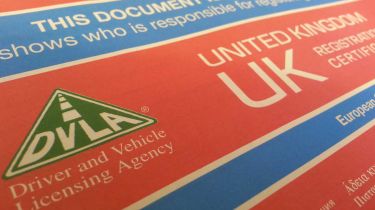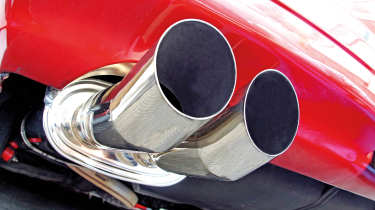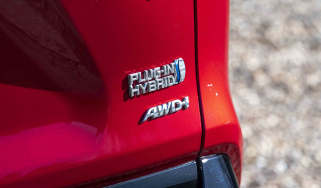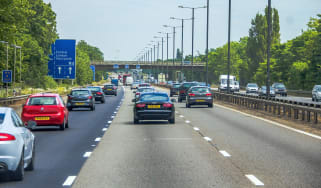What is a V5C? Your car’s log book explained
We cover everything to know about your car’s log book, from changing the address to selling your car

The V5C, also known as the ‘log book’, is perhaps the most important piece of paperwork that comes with car ownership. It’s issued by the Driver and Vehicle Licensing Agency (DVLA) and states the registered keeper, their address, plus important information about the vehicle.
You will need to keep your V5C up to date with your correct name and address, and whether the vehicle is modified in any way. If you’ve lost or damaged your V5C, you can apply for a replacement, and when it comes time to sell your vehicle, there are steps to follow to transfer the V5C to the new keeper. We will take you through all of these scenarios in the guide below.
What is a V5C?
The V5C, or log book, is a paper document issued by the DVLA to the registered keeper of a vehicle. It contains details about your vehicle, including the make and model, when it was first registered, the type of fuel, vehicle identification number (VIN) and more. It also includes information about the registered keeper, including their name and address.
It is important to clarify the distinction between the ‘registered keeper’ and the ‘owner’. The DVLA defines the registered keeper, named on the V5C, as the one who is responsible for registering and taxing the vehicle. This is not necessarily the same person who owns the vehicle, so the V5C cannot be used as proof of ownership. When leasing a vehicle, the leasing company’s name will appear on the V5C, not the driver’s, as the company is responsible for registering and taxing it.
What does a V5C look like?
The V5C is still sent to registered keepers in paper form. It’s likely to remain a physical paper document for the foreseeable future as a special physical watermark helps prevent fraud, although you can update your V5C document via the DVLA website. A car should be supplied with one of the following two types of V5Cs:
- Green and blue document – This is the ‘old style’ variation of the V5C log book and was introduced by the DVLA in 2004. It has 12 sections, with number six being the all-important ‘New keeper details’ section. In section 10, you’ll find the green slip that will be used to transfer the vehicle over to the future owner should you wish to sell your car. This is called the ‘New keeper supplement’ section, or the V5C/2.
- Pink and red document – The ‘new style’ V5C document was first introduced in 2012. The information and section orders are slightly different in these log books, with the most notable changes being that the ‘Selling or transferring my vehicle to a new keeper’ segment is found in section two, and the green ‘new keeper’ slip has moved to section six.
If your car’s log book is still in the older format, it’s worth noting that, while the DVLA has suggested owners should update to the new V5C log books, it’s not a legal requirement.
When do I need to use or update my V5C?
You won’t need to deal with the V5C very often, but be sure to store it in a safe place. The only times you’ll need the V5C are if your name or address changes, if you modify your vehicle, if you sell your vehicle, or if the vehicle is written-off or scrapped. You will also need to use a reference number contained in the V5C for paying Vehicle Excise Duty (VED), known as road tax. However, when you receive a road tax reminder letter, this will also have a reference number to let you pay.
Failure to notify the DVLA of changes can result in a fine of up to £1,000. Vehicle tax reminder letters from the DVLA and VED road-tax refunds will also be sent to the wrong address if you don’t keep it updated. Another reason to keep your address updated is that it could be used to contact you if your vehicle is the subject of a manufacturer recall.

Any major modifications – including to the colour, engine, engine cylinder capacity, fuel type, chassis or body shell (replaced or modified), seating capacity or the weight of a van or campervan – must also all be logged via the V5C and submitted to the DVLA. If you spot any inaccuracies, these should be amended and reported to the DVLA, too. Failing to keep your vehicle’s V5C details up to date and accurate could also invalidate your insurance.
How do I change the address on my V5C?
Changing the address on your V5C is free and straightforward. It can be done online or via post, although the latter usually takes much longer. Don’t forget to also update the address on your driver's licence and VED (road tax) payment details so they match your V5C.
Updating your V5C address online
To update your V5C address online, visit https://www.gov.uk/change-address-v5c and complete the form. The address change will be completed instantly and a new log book should arrive within five days.
You’ll need to have your current V5C document along with the 11-digit log book reference number, the registration number of the vehicle, and a UK address and postcode. Once the change of address is completed, the DVLA will issue you with an email confirmation.
Updating your V5C address by post
You can still change the address on your log book by post, which takes up to six weeks. If you have the new style V5C (issued after 15 April 2019), write your new home address in section three. If you have the old V5C (issued before 15 April 2019), you should complete section six and sign it. Regardless of which version of the V5C you have, you should ensure that you leave the ‘new keeper’ box unticked.
Once completed, you should post the V5C to the DVLA – the address can be found in section three in the new style V5C, or section eight in the old style V5C.
How do I change the name on my V5C?
A change of name on a log book can only be completed by post. You need to enter your new details in section three of a new style V5C, or section six of the older type of V5C. Again, you need to leave the ‘new keeper’ box unticked, and include proof that you’ve legally changed your name, such as marriage or deed poll certificate. If the registered keeper is a business, include proof of its name change (such as a certificate of incorporation from Companies House).
Changing your name and address at the same time must also be done by post. As mentioned above, you must include proof that your name has changed.
I’ve lost my V5C – what do I do?
If you’ve lost your V5C or it’s been stolen or become badly torn or stained, you can apply for a duplicate log book at www.gov.uk/vehicle-log-book. You will need your vehicle’s registration number, the vehicle identification number (VIN) and the name and postcode that your vehicle is registered to. There’s a £25 fee and it should take up to five working days to arrive in the post.
You can also apply for a duplicate log book by calling the DVLA on 0300 790 6802, as long as you’re the registered keeper.
Only use this service if the details on your V5C, such as your name or address, are remaining the same. The duplicate log book must have exactly the same details as the lost, stolen or damaged copy. You cannot use this service if you’re not in possession of the vehicle, the vehicle is part of the DVLA fleet scheme, or it’s registered abroad including the Channel Islands (Jersey and Guernsey), Isle of Man, or Ireland.
How do I fill out my V5C when selling a car?
If you’re selling a car, it’s good practice to ensure you have the V5C for the vehicle and that it’s intact and undamaged. The buyer should check the V5C prior to a sale, so make sure it's ready to go and not tucked away in the attic somewhere. Once you’ve agreed on a deal to sell your car, it’s time to inform the DVLA that the owner of the vehicle has changed.

Filling out the V5C when selling a car – online method
If you plan to inform the DVLA of the new keeper online, you’ll need the new owner’s email address as you’ll have to provide this contact information at www.gov.uk/sold-bought-vehicle.
When you’ve completed the online form, you’ll receive an instant email from the DVLA to confirm the ownership change, followed by a letter in the post. The same also applies if you sell your vehicle to a garage, trader or dealership.
You will then need the paper V5C document to complete section V5C/2 – ‘Selling or transferring my vehicle to a new keeper (not a trader)’. Fill this in, tear it off, and give it to the new owner as proof of the transfer of ownership. You must then destroy the rest of the V5C. The buyer will receive their new V5C in the post.
The online form will prompt the Government to refund you any road tax overpayment on the vehicle, or alternatively, cancel any Direct Debit if you pay monthly – road tax can no longer be transferred between owners.
Filling out the V5C when selling a car – postal method
If you are unable to complete a change of ownership online, you can still fill out the V5C by hand and send it to the DVLA by post when you sell your car.
The process differs slightly between new and old-style V5Cs but, regardless of which one you have, you should always fill it out in block capitals with a black ballpoint pen.
V5C issued after 15 April 2019:
- Seller: complete section two, called ‘selling or transferring my vehicle to a new keeper’
- Seller: fill in the date of sale in section six, called the ‘new keeper slip’, and give it to the buyer
- Seller: send the V5C to ‘DVLA, Swansea, SA99 1BA’.
V5C issued before 15 April 2019:
- Seller: complete section six, called ‘new keeper details’
- Both: sign the declaration in section eight
- Seller: fill in section 10 (also called V5C/2), called the ‘new keeper supplement’, and give it to the buyer
- Seller: send the V5C to ‘DVLA, Swansea, SA99 1BA’.
The buyer should receive their new V5C within two to four weeks.
What do I need to do when buying a car?
If you’re buying a car privately, check beforehand with the owner that they have the V5C, as it could save a wasted trip if the owner needs to get a replacement.
Once you decide to purchase the vehicle, you should always inspect the V5C to ensure it’s genuine. Make sure the owner’s name and address appear correctly and that the details of the vehicle (VIN number, make, colour, engine size, etc.) match the one you’re buying. Also ensure the paper is intact and undamaged, and that any details are filled out in block capitals with a black ballpoint pen.

Check if the owner plans to register the change of ownership online and, if so, supply them with your email address. Ensure you’re given the tear-off V5C/2 ‘new keeper’s details’ to temporarily prove your ownership of the vehicle you’ve bought. You’ll receive an email from the DVLA when the change of ownership is registered and a new V5C will be posted to you.
It’s also important to note that you’ll need to tax or make a Statutory Off Road Notification (SORN) on the new vehicle straight away, as you don’t take ownership of any remaining road tax when you purchase a car.
If the new V5C fails to arrive, you can download a V62 ‘application for a vehicle registration certificate’ form or pick one up from a Post Office. Send this to the DVLA along with the ‘new keeper slip’ (section six) provided by the seller or you’ll be charged a fee. You should receive a V5C within six weeks.
To tax a vehicle as soon as you take ownership, use the website www.gov.uk/vehicle-tax or call 0300 123 4321. Both are available 24/7 and the process should take no more than a few minutes. You’ll need to provide the 12-digit reference number in section six of your V5C ‘new keeper’ supplement.
What if I didn’t get a V5C when I bought a car?
The advice from the DVLA is never to buy a car without a V5C log book as it may be stolen, written off, or have outstanding finance due.
In the unlikely event you did not receive a V5C at the time of buying a car, you can apply for one filling in form V62 that you can download and complete online. You then send this form to the DVLA.
Anyone who doesn’t have a V5C and takes the car out of the UK will need to contact the driving authority in the country they are using the car to register it. You will also need to inform the DVLA by letter that you have taken the vehicle out of the country, giving your name, address, the date you took the car out of the UK and the country it is now registered in. The DVLA will then issue a refund of any road tax you are entitled to.
How do I tell the DVLA my vehicle has been written-off or scrapped?
If your car is written-off or scrapped by your insurance company, you can use an online form to tell the DVLA, available from 7am to 7pm at www.gov.uk/written-off-vehicle.

You’ll be asked to provide your insurance company’s name and postcode in the ‘provide trader details’ sections, along with your vehicle registration number and the 11-digit document reference number that’s printed on the front page of the log book.
Ensure the name and address on the V5C are correct and tell the DVLA by post instead if they need to be updated.
It’s important to inform the DVLA promptly, as you can be fined £1,000 for not reporting that your car has been written-off or scrapped. Your insurance company can ask you for the whole V5C – if this happens (and you haven’t told the DVLA online), write a letter to the DVLA with the details of your insurance company and the date it received the vehicle.
Is there anything else to know about the V5C?
The V5C contains important information about your vehicle, such as the date it was first registered, its make, colour and engine size. When buying a car, it is important to check the chassis number on the V5C matches the one on the car – if it doesn’t it may be a ‘ringer’, a term given to a stolen car that has been given the identity of another car.
The V5C also contains information about your vehicle’s emissions which may be important if you live in an area – such as the London Ultra Low Emissions Zone (ULEZ) – that charges a fee for using a vehicle that doesn’t meet certain emissions standards. You will find this information on page two of the V5C in the section titled ‘Vehicle details’. In subsection D2 under ‘Type’ it will say whether the car is EURO4 (or EURO5, EURO6 etc.).
A car’s tax status is also recorded on the V5C so if you are buying a classic car and want to make sure it qualifies for the zero rate road tax, you need to check it is listed as a ‘Historic Vehicle’ in the taxation class section.
Frequently Asked Questions
Unfortunately not. The V5C is only intended to be a physical document, and there are no plans currently in place for this to change. However, you can use the DVLA’s V62 online form to order a new V5C should you lose yours, or if you need to make any necessary changes to the information currently displayed on your V5C.
Car buying made simple:
Recommended

Petrol and diesel car ban relaxed with hybrids permitted beyond 2030
Most Popular
Tips & advice

Car dashboard warning lights: what does each symbol mean?

Electric car charging stations: public networks, charger types, apps and maps








